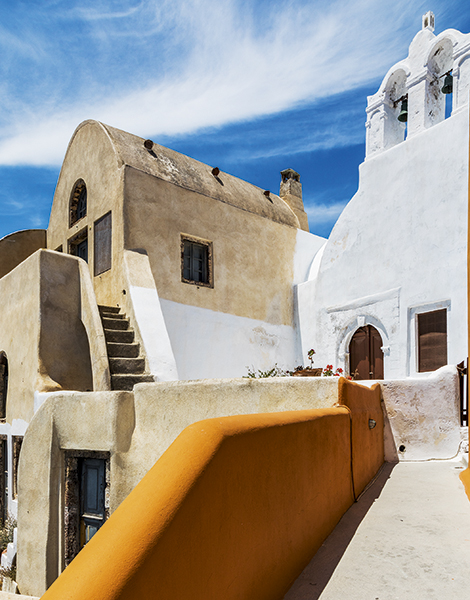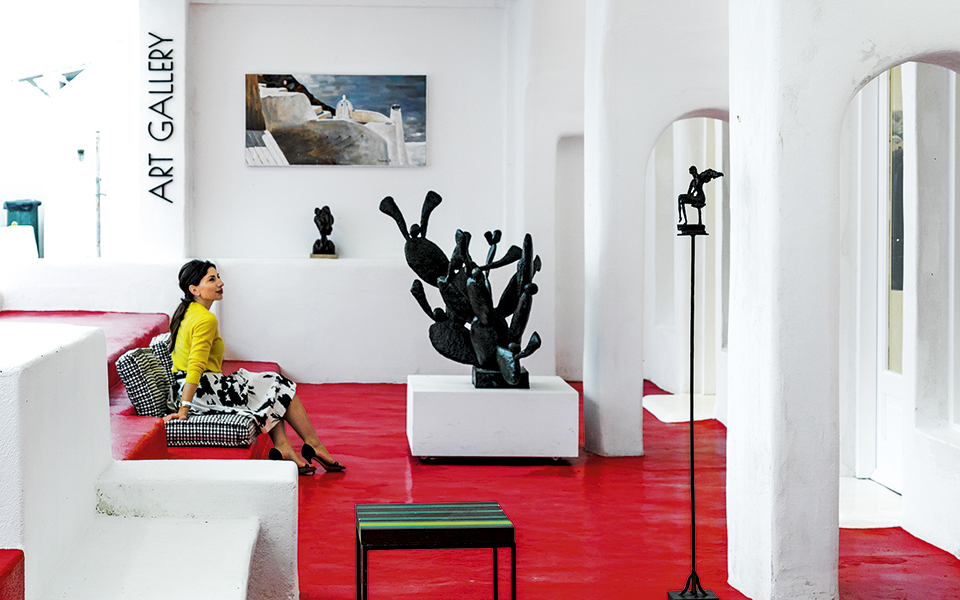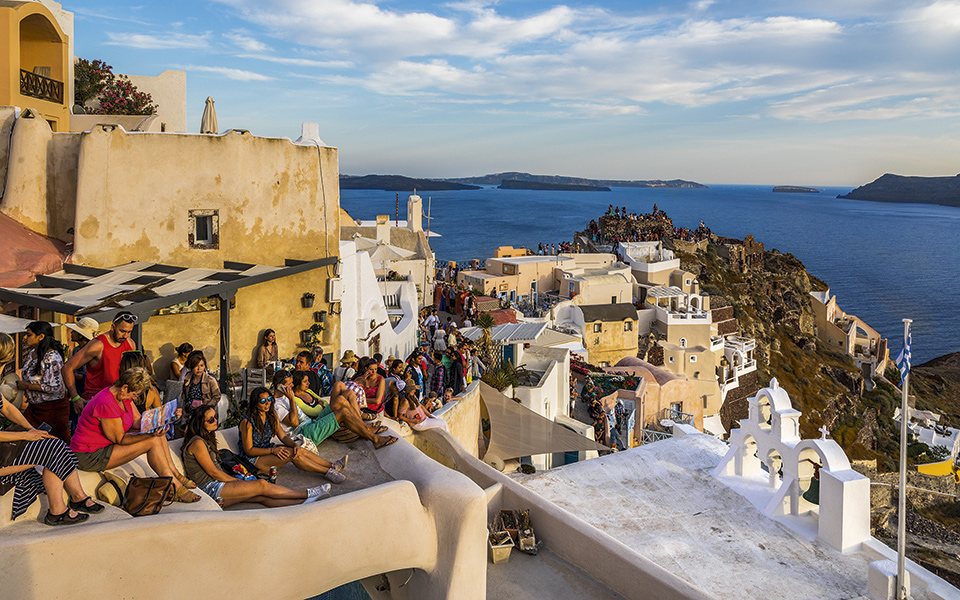If Santorini were a house, then Oia would be its parlor-room. Then again, the balcony might be a more appropriate metaphor, when you consider how it hangs suspended above the Aegean, looking down on Ammoudi Harbor and out over the rest of Santorini and the islands of Therasia and Kameni in the distance.
In the Doric dialect,” explains Nicoletta Nomikou, who was our guide on a recent evening stroll, “the word oia meant ‘far,’ and so when the government in the interwar period sought to bestow a new, more elegant name on the place, it chose Oia, because the village was so far from all the other settlements.”
Up until the 19th century, the village was a prolific shipbuilding center known as Apano (or Pano) Meria, which translates simply as “the upper side.” Its inhabitants, who were called Oiates or Panomerites, were mostly seamen or ship owners, and the boatyard in Armeni built large caiques.
“In the Doric dialect the word oia meant ‘far,’ and so when the government in the interwar period sought to bestow a new, more elegant name on the place, it chose Oia, because the village was so far from all the other settlements.”

© Pericles Merakos

© Pericles Merakos

© Pericles Merakos
Every shipowner was also the captain of his craft, which was typically crewed by family members. They loaded their vessels at Ammoudi Harbor with barrels of Vinsanto, a wine made with sun-dried grapes from the local vineyards and matured in Finikia, in wine cellars known as canaves. This cargo was often destined for the Black Sea, or for the Orthodox communities of Russia, who used Vinsanto wine for Holy Communion.
SaveD by an earthquake
Until the 1950s, this small part of the world, where today hordes of visitors jostle each other and wedding photographers struggle through the crowds to set up the best shot, had no electricity, no paved roads and, of course, no guesthouses or tavernas.
Oia was a sparsely settled village, and its narrow ways were graced not by tourists but by the horses, donkeys and mules used to transport goods or for farm work in the nearby vineyards. All this changed on July 9, 1956, the day of the catastrophic earthquake that flattened the whole village and many other parts of the island. The houses in Oia, which were made of stone and mud, collapsed. The inhabitants scattered in whatever direction they had family. Many would never return.
The center of Oia, that area left and right of the marble-paved street, along with the public squares and churches, was rebuilt within about ten years, along with new homes for the earthquake survivors. Building materials and army personnel were sent from Piraeus for the reconstruction effort.

© Pericles Merakos

© Pericles Merakos
In order to get everything to Oia from the main harbor of Kamari, a road was built. It was, at first, just a dirt track. The new houses were constructed using concrete, with strong foundations and distinctive, barrel-shaped roofs. These “barrels” can still be found along the main road, atop single-story structures now nestled in between luxury dwellings. “Around the same time,” our guide tells us, “electricity arrived on the island and we got a regular boat service.
In 1976, a military airfield was built, which almost immediately began being used for civil aviation, so flights started, and so did tourism. That’s why, in Santorini, we say ‘O sismos, sosmos,’ or, in English, ‘The earthquake was our salvation.’”
COSmOpOlItan anD fOr every taSte
What you might not know about the caldera area, so glamorous today, is that in older times it was inhabited by the poorest islanders, who lived in single-story homes built from aspa, a mixture of volcanic ash, pumice stone and pieces of solidified lava and sand.
The “good” neighborhood was the inland side of the village, or Sideras, where the grand, two-story captain’s houses were located, with their distinctive architectural features and a characteristic transom window above the entrance. Many still survive, either as houses or as restaurants. Today, the traditional village of Oia is one of the most popular destinations for visitors. It is almost as famous as the island of Santorini itself. The castle, whose ruins welcome crowds of romantic visitors every evening, offers a spectacular view of the sunset.

© Pericles Merakos

© Pericles Merakos

© Pericles Merakos
There are a number of world-famous luxury hotels and holiday accommodations with contemporary spa facilities, infinity pools and personal jacuzzis (they come with amazing views, too) as well as dozens of dining options for every budget. There is a hair salon, a post office, a primary and secondary school, a health center and one of the most famous bookshops in the world, Atlantis, housed in an yposkafo carved right into the rock.
The Maritime Museum preserves the history of the village and, with it, much of its character. There is, however, no turning back the clock; while Oia has a permanent population of only 1,000, with over 8,000 visitors a day from cruise ships alone, it becomes, for a few hours at a time, a very popular and lively place.
artS anD CraftS
Walk along the central, marble-paved road which joins the luxury Canaves Oia Hotel to the castle, a distance of about one kilometer. This is the starting point for your descent towards the hotels and restaurants of the caldera; it’s also the main commercial street, lined with shops of every kind.
Boutiques here feature both Greek and international designers: Soho-Soho for the best-known global brands and fashion houses; retro-style gowns in the elegant boutique of Vassilis Emmanuel Zoulias; design accessories from Andronis Boutiques; and silk, cashmere and wool accessories at the Silk Shop.

© Pericles Merakos

© Pericles Merakos

© Pericles Merakos
In smaller shops, look for handmade Greek creations by young designers such as Ioanna Kourbela. Stunning jewelry by Greek designers and jewelers shine in the display cases of boutiques like Poniros. Check out the classic gold designs by Alexandros, or discover jewelry, ornaments, paintings and other vintage paraphernalia in Oia’s only antique shop, which resembles a small, open-air bazaar.
Distinguished artists also maintain their own galleries in Oia. Worth visiting are Asimis-Kolaitou AK Art Gallery; Kyrkos Art Gallery; photographer Nikos Rigopoulos’ Oria Gallery; and the workshop of Dimitris Koliousis, a self-taught icon painter who has also decorated Panaghia Episkopi Church.
Lesser-known artists from all over Greece – potters, jewelers, artists working in stone and fabric, sculptors and painters – also send work to be displayed and sold on this illustrious stage. With this much talent around, it could take you several strolls to find what’s perfect for you.
Many thanks to our guide, Nicoletta Nomikou, who is available for tours. Tel. (+30) 693.221.4130).












